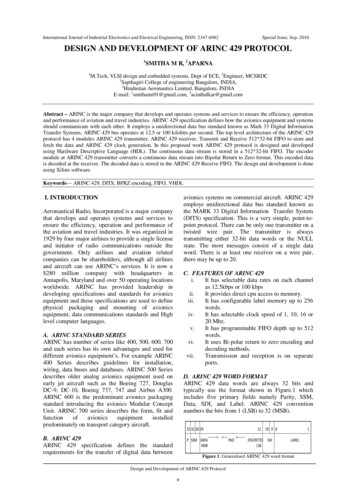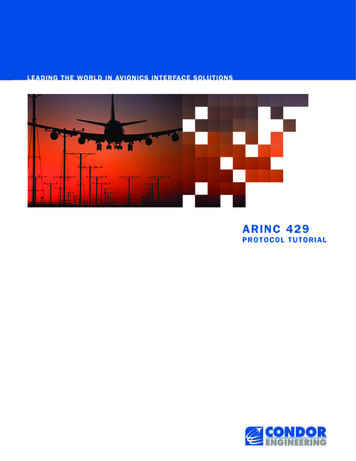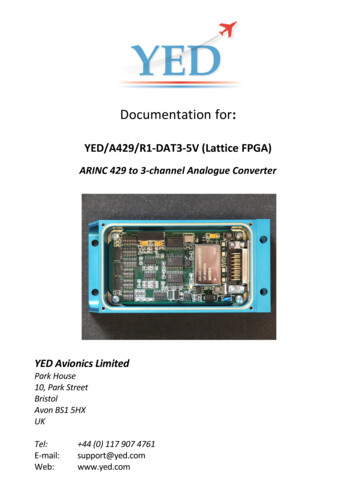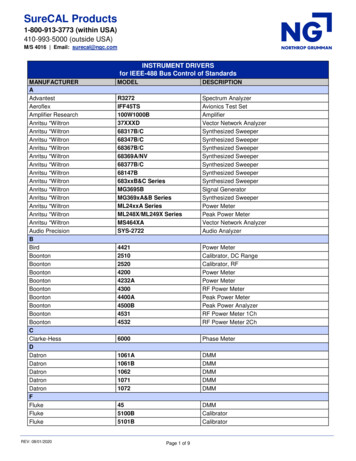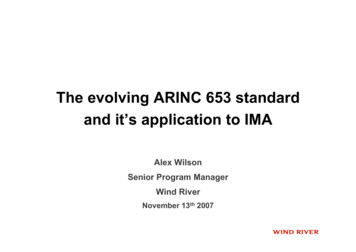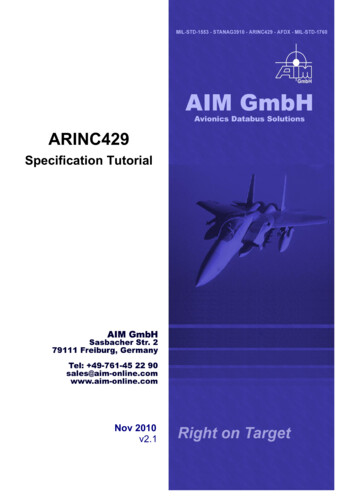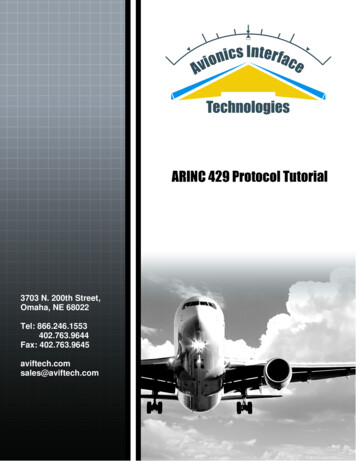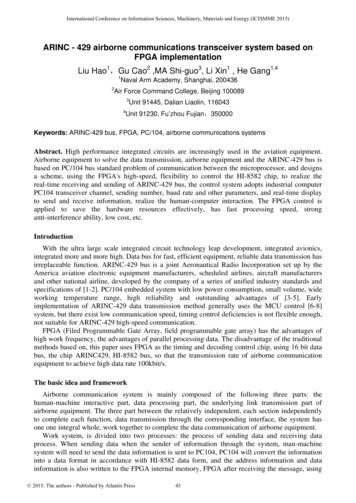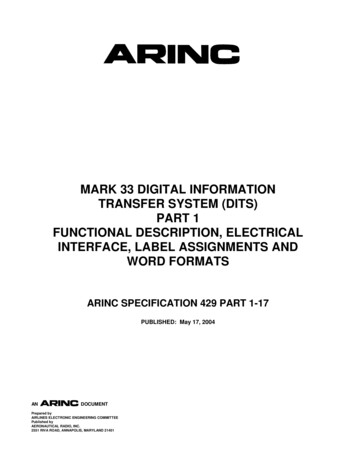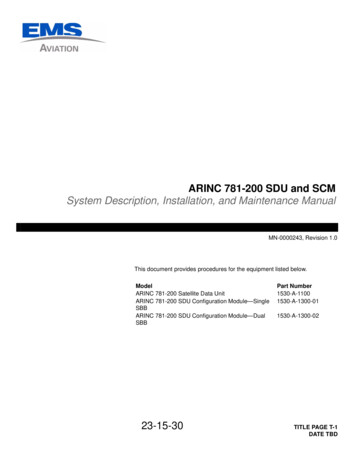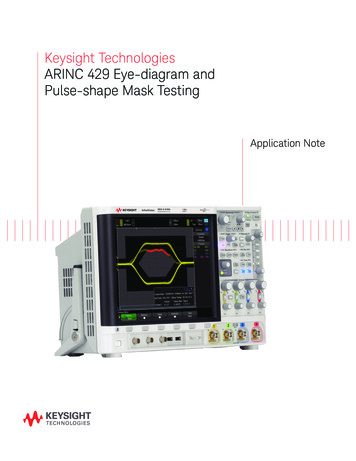
Transcription
Keysight TechnologiesARINC 429 Eye-diagram andPulse-shape Mask TestingApplication Note
IntroductionEye-diagram mask testing is used in a broad range of today’s serial bus applications. An eye-diagram isbasically an overlay of all bits captured by the scope to show when bits are valid and not valid. This providesa composite picture of the overall quality of a system’s physical layer characteristics, which includesamplitude variations possibly due to transmission line affects, reflections, system noise, over-shoot, ringing,signal edge timing, and jitter.Eye-diagram and pulse-shape pass/fail mask testing can be performed on differential ARINC 429 signalsusing a Keysight Technologies, Inc. 3000T, 4000 or 6000 X-Series oscilloscope licensed with the DSOX3AERO/DSOX4AERO/DSOX6AERO triggering and decode option (MIL-STD 1553 and ARINC 429), alongwith the DSOX3MASK/DSOX4MASK/DSOX6MASK mask test option. Various ARINC 429 mask files can bedownloaded from Keysight’s website at no charge. Save the appropriate ARINC 429 mask files (based onbaud rate) to your personal USB memory stick and then insert the memory stick into the scope’s front-panelUSB port. The following ARINC 429 mask files are available:–– ARINC429 100 kbps Eye Test.msk–– ARINC429 100 kbps 1’s Test.msk–– ARINC429 100 kbps 0’s Test.msk–– ARINC429 100 kbps Null Test.msk–– ARINC429 12,5 kbps Eye Test.msk–– ARINC429 12,5 kbps 1’s Test.msk–– ARINC429 12,5 kbps 0’s Test.msk–– ARINC429 12,5 kbps Null Test.msk
03 Keysight ARINC 429 Eye-diagram and Pulse-shape Mask Testing - Application NoteProbing the Differential ARINC 429 BusARINC 429 mask testing is based on capturing and overlaying all “1” and/or “0” bits of thedifferential bus. The differential bus must be probed using a differential active probe. Keysightrecommends using the N2818A 200-MHz differential active probe shown in Figure 1. Alsoavailable is the N2791A 25-MHz differential active probe.Figure 1. Keysight’s N2818A 200-MHz differential active probe.ARINC 429 Eye-diagram Mask TestTo perform an ARINC 429 eye-diagram mask test, do the following:1. Press the [Default Setup] front panel key.2. Press the [Save/Recall] front panel key; then press the Recall softkey.3. Press the Recall: XXXX softkey; then select Mask as the type of file to recall.4. Press the Location (or Press to go, or Load from) softkey; then navigate to the mask file named“ARINC429 100 kbps Eye Test.msk” or “ARINC429 12,5 kbps Eye Test.msk” based on theappropriate baud rate of your ARINC 429 system.5. Press the Press to Recall softkey (or press the entry knob) to begin an eye-diagram mask test.www.keysight.com/find/morescope
04 Keysight ARINC 429 Eye-diagram and Pulse-shape Mask Testing - Application NoteARINC 429 Eye-diagram Mask Test (Continued)When the mask file is recalled, in addition to recalling the pass/fail limit mask, the scope willautomatically be configured in the follow state:–– Probe attenuation: 10:1–– Vertical scaling: 4.00 V/div–– Horizontal scaling: 1.000 µs/div for 100 kbps, or 20.00 µs/div for 12.5 kbps–– Delay: 2.5 µs for 100 kbps, or 10.0 µs for 12.5 kbps–– Upper threshold level: 3.00 V–– Lower threshold level: –3.00 V–– Triggering: All bits (rising edge crossings at 3 V and falling edge crossings at –3 V–– Noise reject: On–– BW limit (20 MHz): OnFigure 2 shows an ARINC 429 eye-diagram mask test on a differential bus based on a baudrate of 100 kbps. This particular test shows a “1’s” pulse failing the mask test due to insufficientamplitude. 13 V 6.5 V 2.5 V4.5 µs at 100 kbps–2.5 V–6.5 V–13 VFigure 2. ARINC 429 eye-diagram mask test on 100 kbps data.The top and bottom of the center eye mask region (6-point polygon) is based on the specifiedminimum input differential voltage levels (HI and LO) of 6.5 V. The upper and lower maskregions test against the specified maximum input voltage levels of 13.0 V, as well as themaximum null voltage levels of 2.5 V (ARINC 429 Specification, Part 1 – Page 75).The width of the eye mask is based on the minimum specified half-bit width (Time X) of 4.75 µsfor 100 kbps or 38.0 µs for 12.5 kbps. The beginning of the eye mask region is based on the 3.0 V threshold crossing time-point plus 125 ns for 100 kbps, or plus 1 µs for 12.5 kbps ([idealhalf-bit width – specified half-bit width]/2). And the slopes of the leading and trailing edges ofthe center eye mask region are based on the maximum pulse rise and fall times of 2.0 µs for100 kbps and 15 µs for 12.5 kpbs (ARINC 429 Specification, Part 1 – Page 118).To exit an ARINC 429 mask test, either turn off mask testing or press Clear Mask in the scope’s[Analyze] menu.www.keysight.com/find/morescope
05 Keysight ARINC 429 Eye-diagram and Pulse-shape Mask Testing - Application NoteARINC 429 “1’s” Pulse TestTo perform a pulse mask test based on just “1’s” (HI pulses), recall the “ARINC429 100 kbps1’s Test.msk” or “ARINC429 12,5 kbps 1’s Test.msk” mask file based on the appropriate baudrate of your ARINC 429 system. Triggering for this test is based on rising edge crossings of“1’s” pulses only at the upper threshold level of 3.0 V. In addition to performing a mask test onjust “1” pulses, this test will also turn on and display various parametric timing and amplitudemeasurements with continuously updated statistics as shown in Figure 3. The minimum andmaximum values of these measurements can be compared against ARINC 429 publishedelectrical specifications.Figure 3. ARINC 429 “1’s” pulse mask test with parametric measurements.For an ARINC 429 “1’s” test, compare the following on-screen oscilloscope measurements tothe following published electrical specifications:–– Compare Top(Ch#)Min against the minimum input high level specification of 6.5 V.–– Compare Top(Ch#)Max against the maximum input high level specification of 13.0 V.–– Compare Rise(Ch#)Max against the maximum rise time specifications of 2.0 µs for 100 kbpsor 15 µs for 12.5 kbps.–– Compare Fall(Ch#)Max against the maximum fall time specifications of 2.0 µs for 100 kbpsor 15 µs for 12.5 kbps.–– Compare Width(Ch#)Min against the minimum half-bit width specification of 4.75 µs for100 kbps or 38.0 µs for 12.5 kbps.–– Compare Width(Ch#)Max against the maximum half-bit width specification of 5.25 µs for100 kbps or 42.0 µs for 12.5 kbps.In the example shown in Figure 3, Top(1)Min measured 5.4 V. This fails to meet the minimumrequired input high level specification of 6.5 V. This is also indicated in red in the mask testwhere some high level pulses cross through the mask region. In addition, Width(1)Min, whichmeasured 4.7233 µs, fails to meet the minimum half-bit width specification 4.75 µs for a100 kbps ARINC 429 system. All other measurements pass.www.keysight.com/find/morescope
06 Keysight ARINC 429 Eye-diagram and Pulse-shape Mask Testing - Application NoteARINC 429 “0’s” Pulse TestTo perform a pulse mask test based on just “0’s” (LO pulses), recall the “ARINC429 100 kbps0’s Test.msk” or “ARINC429 12,5 kbps 0’s Test.msk” mask file based on the appropriate baudrate of your ARINC 429 system. Triggering for this test is based on falling edge crossings of“0’s” pulses only at the lower threshold level of –3.0 V. In addition to performing a mask test onjust “0” pulses, this test will also turn on and display various parametric timing and amplitudemeasurements with continuously updated statistics as shown in Figure 4. The minimum andmaximum values of these measurements can be compared against ARINC 429 publishedelectrical specifications.Figure 4. ARINC 429 “0’s” pulse mask test with parametric measurements.For an ARINC 429 “0’s” test, compare the following on-screen oscilloscope measurements tothe following published electrical specifications:–– Compare Base(Ch#)Max against the minimum input low level specification of –6.5 V.–– Compare Top(Ch#)Min against the maximum input low level specification of –13.0 V.–– Compare Rise(Ch#)Max against the maximum rise time specifications of 2.0 µs for 100 kbpsor 15 µs for 12.5 kbps.–– Compare Fall(Ch#)Max against the maximum fall time specifications of 2.0 µs for 100 kbpsor 15 µs for 12.5 kbps.–– Compare -Width(Ch#)Min against the minimum half-bit width specification of 4.75 µs for100 kbps or 38.0 µs for 12.5 kbps.–– Compare -Width(Ch#)Max against the maximum half-bit width specification of 5.25 µs for100 kbps or 42.0 µs for 12.5 kbps.Although the mask test does not indicate any failures for the example shown in Figure 4, notethat the -Width(1)Min measurement, which measured 4.7123 µs, fails to meet the minimumhalf-bit width specification of 4.75 µs for a 100 kbps ARINC 429 system.www.keysight.com/find/morescope
07 Keysight ARINC 429 Eye-diagram and Pulse-shape Mask Testing - Application NoteARINC 429 “Null” TestTo perform a noise mask test based on just “null” signal levels between all “1” and “0” pulses,recall the “ARINC429 100 kbps Null Test.msk” or “ARINC429 12,5 kbps Null Test.msk” mask filebased on the appropriate baud rate of your ARINC 429 system. Triggering for this test is basedon the “All bits” trigger setting (same as eye test). In addition to performing a mask test on justthe null level signal between pulses, this test will also turn on and display various parametricamplitude measurements with continuously updated statistics in order to characterize noiseas shown in Figure 5. The maximum values of these displayed measurements can be comparedagainst ARINC 429 published electrical specifications.For an ARINC 429 “Null” test, compare the following on-screen oscilloscope measurements tothe following published electrical specifications:–– Compare Max(Ch#)Max against the maximum null level specification of 2.5 V.–– Compare Min(Ch#)Min against the minimum null level specification of –2.5 V.–– Avg–FS(Ch#)Mean provides the average null level for information purposes only.–– AC RMS-FS(Ch#)Mean provides the RMS noise level (standard deviation) for informationpurposes only.Figure 5. ARINC 429 “null” mask test with parametric measurements.System RequirementsIn addition to requiring the Keysight N2818A differential active probe (or equivalent) to probethe differential bus, performing ARINC 429 eye-diagram and pulse-shape mask tests requiresthat your Keysight 3000T, 4000 or 6000 X-Series oscilloscope be licensed with the DSOX3AERO/DSOX4AERO/DSOX6AERO serial trigger and decode option (MIL-STD 1553 and ARINC429), as well as the DSOX3MASK/DSOX4MASK/DSOX6MASK mask test option.www.keysight.com/find/morescope
08 Keysight ARINC 429 Eye-diagram and Pulse-shape Mask Testing - Application NoteRelated LiteraturePublication titleInfiniiVision 3000T X-Series Oscilloscopes - Data SheetInfiniiVision 4000 X-Series Oscilloscopes - Data SheetInfiniiVision 6000 X-Series Oscilloscopes - Data SheetSerial Bus Options for InfiniiVision X-Series Oscilloscopes - Data SheetMask/Waveform Limit Testing For InfiniiVision Series Oscilloscopes - Data SheetN2792A/N2818A 200 MHz and N2793A/N2819A 800 MHz Differential Probes - Data SheetN2790A 100 MHz, N2791A 25 MHz and N2891A 70 MHz High-voltage Differential Probes - Data SheetOscilloscopes in Aerospace/Defense Debugging MIL-STD 1553 Serial Buses - BrochureEvaluating Oscilloscope Mask Testing for Six Sigma Quality Standards - Application NotePublication 200ENTo download these documents, insert the publication number in the 5992-0140EN.pdfProduct Web siteFor the most up-to-date and complete application and product information, please visit ourproduct Web site at: www.keysight.com/find/morescopeKeysight OscilloscopesMultiple form factors from 20 MHz to 90 GHz Industry leading specs Powerful applicationswww.keysight.com/find/morescope
09 Keysight ARINC 429 Eye-diagram and Pulse-shape Mask Testing - Application NoteEvolving Since 1939Our unique combination of hardware, software, services, and people can help youreach your next breakthrough. We are unlocking the future of technology.From Hewlett-Packard to Agilent to tA personalized view into the information most relevant to you.http://www.keysight.com/find/emt product registrationRegister your products to get up-to-date product information andfind warranty information.Keysight Serviceswww.keysight.com/find/serviceKeysight Services can help from acquisition to renewal across yourinstrument’s lifecycle. Our comprehensive service offerings—onestop calibration, repair, asset management, technology refresh,consulting, training and more—helps you improve product qualityand lower costs.Keysight Assurance Planswww.keysight.com/find/AssurancePlansUp to ten years of protection and no budgetary surprises to ensureyour instruments are operating to specification, so you can rely onaccurate measurements.Keysight Channel Partnerswww.keysight.com/find/channelpartnersGet the best of both worlds: Keysight’s measurement expertise andproduct breadth, combined with channel partner convenience.For more information on KeysightTechnologies’ products, applications orservices, please contact your local Keysightoffice. The complete list is available azilMexicoUnited States(877) 894 441455 11 3351 7010001 800 254 2440(800) 829 4444Asia PacificAustraliaChinaHong KongIndiaJapanKoreaMalaysiaSingaporeTaiwanOther AP Countries1 800 629 485800 810 0189800 938 6931 800 11 26260120 (421) 345080 769 08001 800 888 8481 800 375 81000800 047 866(65) 6375 8100Europe & Middle rlandUnited Kingdom0800 0011220800 585800800 5232520805 9803330800 62709991800 8327001 809 343051800 599100 32 800 585800800 02332008800 5009286800 0001540200 8822550800 805353Opt. 1 (DE)Opt. 2 (FR)Opt. 3 (IT)0800 0260637For other unlisted 7)www.keysight.com/find/morescopeDEKRA CertifiedISO9001 Quality Management Systemwww.keysight.com/go/qualityKeysight Technologies, Inc.DEKRA Certified ISO 9001:2015Quality Management SystemThis information is subject to change without notice. Keysight Technologies, 2011 - 2018Published in USA, March 1, 20185990-9325ENwww.keysight.com
ARINC 429 "0's" pulse mask test with parametric measurements. For an ARINC 429 "0's" test, compare the following on-screen oscilloscope measurements to the following published electrical specifications: - Compare Base(Ch#)Max against the minimum input low level specification of -6.5 V.

